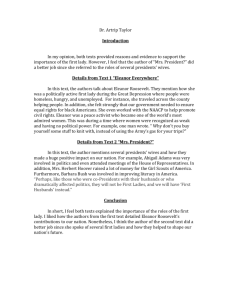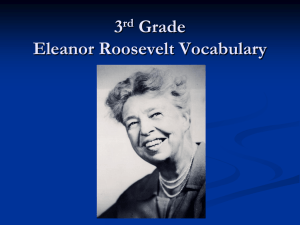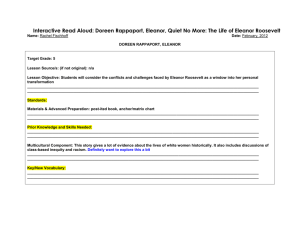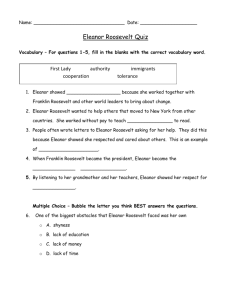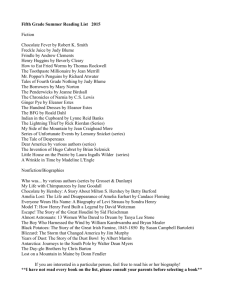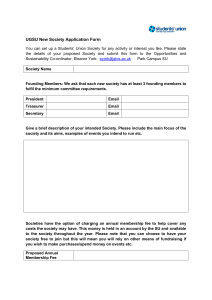documenting and writing the teacher evaluation
advertisement
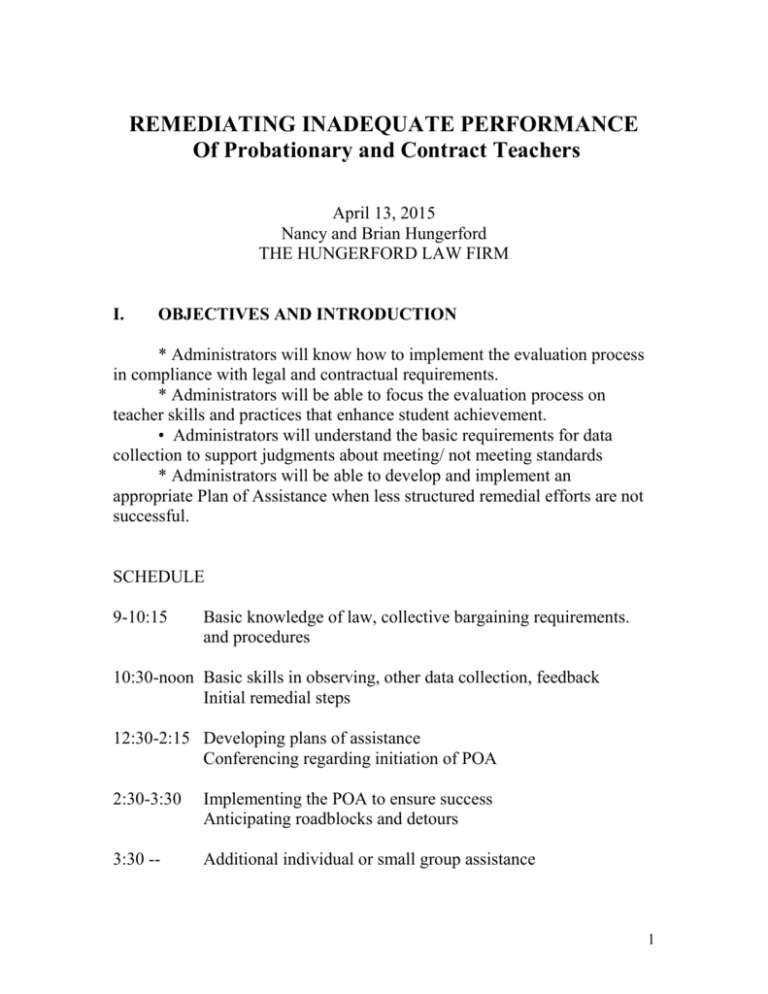
REMEDIATING INADEQUATE PERFORMANCE Of Probationary and Contract Teachers April 13, 2015 Nancy and Brian Hungerford THE HUNGERFORD LAW FIRM I. OBJECTIVES AND INTRODUCTION * Administrators will know how to implement the evaluation process in compliance with legal and contractual requirements. * Administrators will be able to focus the evaluation process on teacher skills and practices that enhance student achievement. • Administrators will understand the basic requirements for data collection to support judgments about meeting/ not meeting standards * Administrators will be able to develop and implement an appropriate Plan of Assistance when less structured remedial efforts are not successful. SCHEDULE 9-10:15 Basic knowledge of law, collective bargaining requirements. and procedures 10:30-noon Basic skills in observing, other data collection, feedback Initial remedial steps 12:30-2:15 Developing plans of assistance Conferencing regarding initiation of POA 2:30-3:30 Implementing the POA to ensure success Anticipating roadblocks and detours 3:30 -- Additional individual or small group assistance 1 HOMEWORK #1: Describe in one paragraph your biggest performance concerns: PROBATIONARY TEACHER: _____________________ _______________________________________________ _______________________________________________ _______________________________________________ Standard(s) closely aligned?________________________ CONTRACT TEACHER __________________________ _______________________________________________ _______________________________________________ _______________________________________________ _______________________________________________ _______________________________________________ Standard(s) closely aligned?________________________ 2 II. LEGAL AND CONTRACTUAL REQUIREMENTS A. O.R.S. 342.815 and .850 • Definition of a Program of Assistance for Improvement • The “regular evaluation process” • The process when deficiencies are noted B. O.R.S. 856 (S.B. 290) and the Framework • Impact of new standards and Matrix • Integrating student L&G goals with evaluation for struggling teachers C. Your collective bargaining provisions for teachers • “Employee Evaluation” article • “Programs of Assistance for Improvement” • Representation rights in the evaluation process • Personnel files and working files • Complaint Procedure D. Additional requirements in your Evaluation Handbook • Frequency, timing of observations and evaluations • Requirements for feedback (oral and/or written) • Additional steps if deficiencies are identified? 3 HOMEWORK #2: What does your COLLECTIVE BARGAINING AGREEMENT and EVALUATION HANDBOOK say? • FREQUENCY/KIND OF OBSERVATIONS ______________________ ____________________________________________________________ • FREQUENCY/KIND OF CONFERENCES ABOUT PERFORMANCE: ____________________________________________________________ • GOAL SETTING FOR PROFESSIONAL PRACTICE/RESPONSIBILITY? ____________________________________________________________ • ANY PRE-CONDITIONS TO A PLAN OF ASSISTANCE? ____________________________________________________________ • REQUIREMENTS REGARDING A PLAN OF ASSISTANCE? ____________________________________________________________ ____________________________________________________________ ____________________________________________________________ • RIGHT TO APPEAL A DISMISSAL OR NON-RENEWAL DECISION? ____________________________________________________________ 4 III. GOAL-SETTING TO ENHANCE STUDENT ACHIEVEMENT A. How do Student Learning and Growth goals relate to your concerns about teacher performance deficits, known or suspected (if at all)? RECENT SL&G GOAL AREAS:_____________________ ________________________________________________ RELATED PP/PR GOAL AREAS: ___________________ ________________________________________________ ________________________________________________ B. Goal-setting in Professional Practice and/or Professional Responsibilities May be connected to SL&G goals or completely separate May be administrator-directed May focus on adult-adult relationships and communication EXAMPLES Ask teachers to develop at least one goal in professional practice that will address the challenges in reaching a SL&G goal, based on preliminary data collection, classroom observation. Ask teachers to focus on skills in organization, leadership in collaborating with parents, other staff, classified employees Write a goal to address observed impediments to success for lowachievers (i.e., lack of positive reinforcement, low expectations for student work, lack of engagement, etc.). Write a goal to address instructional practice with high achievers who may not be challenged by regular instruction. 5 IV. INITIAL REMEDIATION STEPS A. Observations of Performance: Classroom Observations 1. Initial observations • Can be a formal observation (pre-scheduled) OR several miniobservations or an informal observation of 20-30 minutes • Review prior evaluation, goals to determine area(s) of focus • Review your areas of concern, based on all information you have • Determine best opportunity (class, time of day, activity) for gathering useful information • Review lesson plans for the week/unit to determine where this lesson fits in. • Choose an observation time based on your questions about effectiveness (test scores in certain subjects, classes with many ESOL students, etc.) • Determine in advance your data gathering method(s): Anecdotal (but focused): On-task data collection: Selective verbatim: Interaction analysis (focused): Other: 6 OBSERVATION REPORTS: TITLE 1 READING SPECIALIST Your concerns about the Title I Reading Specialist have included (1) lack of individualized instruction, (2) lack of varied and appropriate activities, and (3) failure to assess pupils’ progress daily and to reteach as necessary. You ask both assistant principals to do drop-in observations and write up observation reports to use in conferencing: “The classroom was disorganized and you couldn’t find materials you were looking for. You attempted to provide an anticipatory set, but it didn’t come off. You failed to provide any individualized instruction. It didn’t seem to me that the students understood the direct instruction, but you didn’t try to reteach. They appeared bored with the lesson, probably because you didn’t use any activities except the workbook. The students weren’t behavior problems, but they didn’t seem involved in the lesson.” - Doris Knight, Assistant Principal “I entered the classroom at 9:05. Seven students were seated at two tables. You were looking through piles of paper on your desk. At 9:08 you told students that they were to turn to page 15 in their workbooks. Several students said they had not brought their workbooks with them, so you went to a filing cabinet and after a few minutes found additional workbooks for them. You placed the letters “c”, “ch” and “k” on the board and asked students to sound them out. You then wrote a number of words on the board, including “cease” and “cedar” and asked students to pronounce them. Some students attempted to pronounce the words with a hard “c” sound; others gave correct pronunciation. You asked students to think why the “c” was pronounced like an “s” in these words. None of the students came up with the correct answer, so you supplied it. “You then told students to do pages 15-16 in their workbooks and you would come around and correct their pages when they were through. Students were quiet, but two of the boys were doodling on pieces of paper and stating around the room. When Esther raised her hand, you got up from your desk and answered a question for her. Several students finished the pages in five minutes. The other students were still working when you told them to get ready to go back to their classroom. The students left at 9:25.” --Donna Dey, Assistant Principal What suggestions will you give to Dey and Knight about their observation techniques and observation summaries? 7 2. Setting the stage for the next observation/data gathering: --“I’d like to see another lesson from later on in this unit. . .” --“I see from your lesson plans that you are planning a cooperative learning activity in this same unit for Thursday. I may drop in. . .” --“I’m going to plan to do a drop-in observation sometime in the next month. I’ll be specifically looking to see you use the strategies we’ve talked about to bring all students to attention before proceeding, and reducing the “down time” during the period.” --“I would like to see the final papers the students produce as a result of this writing project, after you have scored and graded them” --“We’ve talked about your overall plans for this unit, some things that went well and other things that didn’t. I’d like to see how you revise your lesson plans based on this first day of instruction and also see how you’re going to differentiate instruction.” 3. Planning for a subsequent observation(s) --Generally plan to do a drop-in observation for most of the period. --If the first observation was satisfactory, plan to see the teacher in a different class, subject matter, or instructional format. --If first observation was unsatisfactory, plan a return in a few weeks --If the first observation was unsatisfactory in some respect(s), do a second observation with the same class, same subject matter, same activity and tell the teacher you want to see implementation of 3-4 suggestions or directions you have given in the first post-observation conference. --If continuity or sticking to the curriculum is an issue, drop in the day after a formal observation to see if the next day’s lesson is comparable or there is a “let down” or disconnect. --If there’s a specific concern such as teacher not interacting with students, lost time at the beginning or end of classes, etc., plan a number of five- or ten-minute drop-ins, with a consolidated observation report. 8 4. Writing the classroom observation report --Note the data, class period (or time of day), number of students in class, and any unusual situations. --Include an objective summary of the events of the observation period. --Include a section of analysis and judgment about how the teaching performance met or did not meet specific District standards. --Include specific suggestions for improvement. --Recognize areas of strength or good performance, but be sure that the overall tone and impression is not misleading to the teacher. --Attach your actual in-class notes or make them available if you do a short summary observation report. --Provide your observation report either as a draft, or write in changes if teacher brings additional information to you. --File observation reports in your working file but attach to final evaluation (or have a system good enough to maintain them for years). B. Observations in non-classroom settings •Let the teacher know that you may be observing in non-classroom settings as needed to determine performance on some standards • Examples: IEP meetings, PLC and other small group staff meetings, parent meetings • Prompt feedback is a must • Use email to identify major points and invite a meeting • Keep in working file along with other data C. Other data collection • Use verified complaints that have been processed through the complaint procedure • Use file reviews (IEP files, grade books, communications with parents) • Review selected lesson plans, corrected and graded student work • Give feedback, ask for corrective action 9 HOMEWORK #3: Given performance concerns identified in #1, in the next observation WHAT SPECIFIC DATA WILL YOU FOCUS ON AND HOW WILL YOU GATHER IT? Standard Descriptor #1: ___________________________ _______________________________________________ _______________________________________________ Observation Method?_____________________________ Standard Descriptor #2: __________________________ _______________________________________________ _______________________________________________ _______________________________________________ Observation Method?______________________________ _______________________________________________ Other types of Data Gathering_______________________ _______________________________________________ 10 HOMEWORK #4: V. SIGNALING AN “ESCALATION OF CONCERN” A. Clearly communicating, “This lesson did not meet standards in the following areas.” B. Revising, adding “directed goals” _____________________________________ _____________________ _____________________________ _____________________________ _____________________________ C. Involvement of Association at this point? Representation rights? D. Assistance at this point? E. Addressing potential need for POA F. Be prepared to defend your level of concern and specific concerns 11 VII. WRITING THE EVALUATION A. Make a statement about whether the teacher met all District standards: “In his first probationary year, the focus of the evaluation was Jerry’s success in meeting District standards on classroom management, lesson planning, and instructional techniques. He met standards on lesson planning and instructional techniques. Based on my four observations, especially the observations of 12/5 and 2/7, Jerry does not consistently meet our standards on classroom management; he needs to keep students on task throughout the class period and to enforce his classroom rules from the very beginning of the class period, so that students are immediately brought back to task.” “Julie is a veteran teacher who continues to meet all District standards. Julie excels in motivating students and in establishing relationships with many at-risk students. During this evaluation period, I gathered information particularly about her assessment strategies and activities. While she meets standards in this area, I would like to see her use the results of her daily and unit assessment more to shape subsequent instruction so it meets the needs of the diverse learners in her classrooms.” B. Make a statement about progress on goals, but don’t forget the standards! C. Make a statement about areas for improvement and growth with specific suggestions. D. Determine numeric ratings for each area of PP/PG standards. E. Determine numeric ratings for Student L&G goals. Complete Matrix; determine final rating Determine Professional Growth Plan model for next evaluation period 12 CASE STUDY: CONTRACT TEACHER (MIDDLE SCHOOL SPECIAL EDUCATION) Eleanor R____ is finishing her fourth year as a special education teacher in the district, assigned to a middle school as a Resource Room teacher. During her first year the principal’s evaluation said: “Eleanor faces the same challenges all of us in special education face: keeping up with the changes in the law and the changes in federal and state regulations. Eleanor can continue to improve in writing PLOP’s (Present Levels of Performance), annual goals, objectives and the other aspects of the IEP process.” During her second year, as the result of the ODE special education audit, she and other teachers were given a list of corrective actions to be taken to ensure that her record-keeping met state requirements. Her principal noted in her evaluation that she was “gaining a better understanding of the laws and regulations which govern special education,” but stated that “Eleanor must become more involved with regular ed language arts and math teachers so as to teach those skills needed by students to meet proficiency standards by 8th grade, if possible.” In her third year, a new special education coordinator was assigned to work with Eleanor; the coordinator provided very close supervision and much assistance and saw growth. Eleanor was marked as meeting all performance standards, but it was noted that “Eleanor has made progress but continues to struggle in meeting all legal requirements and record-keeping requirements for IDEA. Eleanor must ensure that IEP goals and instruction in reading, writing and math are tied to state requirements.” Eleanor was moved to contract status. In her fourth year, Eleanor wrote Student L& G goals as follows: “(1) To create a safe classroom environment that meets the needs of students with a variety of learning differences (ED, LD, ADHD, Asperger’s) and to promote their ability to focus attention on academic issues. (2) To use regular data collection to assess students’ progress and to modify instruction to enhance student progress on IEP goals, especially those related to state curriculum requirements. 13 In keeping with your District practice, Eleanor also wrote this PP/PG goal: To increase parent volunteer time in my classroom, including recruiting and training volunteers. In October of the fourth year, Eleanor was notified by the principal of concerns about her in-classroom performance: “This fall I will observe you teaching both informally and formally and offer specific suggestions for improvement; we may need to discuss a plan of assistance for improvement.” Also beginning in October, the director began checking some of Eleanor’s more recently written IEPs and communicated in a note that they did not meet expectations for goals and objectives and “at least informal measurements of student progress.” The principal observed that much of students’ time in the Resource Room was used to complete homework from other classes. The principal noted, in several drop-ins, that Eleanor was reading at her desk or working on her computer, while the students were working independently or with an instructional assistant. The principal wondered whether any data was being kept about progress on IEP goals. What steps should be taken, by the principal and special education coordinator, to document and utilize data-gathering in the areas of concern? Can anything be done about the Student L&G goals now? What should happen now and at the end-of-year L&G goal conference? Knowing that Eleanor does not typically agree with any criticism of her teaching or record-keeping, what steps will the administrators need to take to be ready to move to a Plan of Assistance if they do not see any improvement occurring in the next few weeks? 14 RAGING RIVER SCHOOL DISTRICT PROGRAM OF ASSISTANCE FOR IMPROVEMENT Teacher: Eleanor R____________ Date: ________________ Assignment: Middle school resource room STATEMENT OF AREAS NEEDING IMPROVEMENT 1. Student Instruction Eleanor does not consistently plan and implement specially designed instruction that is linked to completion of goals on the IEPs, especially goals tied to academic achievement, and does not maximize the use of direct instruction while students are in the Resource Room. 2. Meeting Legal Requirements and Record-Keeping Eleanor’s files do not consistently meet all of the requirements of IDEA, as required forms are often missing or incomplete, the PLOPs on IEPs are often too vague to guide planning of goals, and the goals and objectives are not measurable or specific. Regular progress reporting, based on data collected regarding progress on the goals, is often missing or inadequate. EXPECTATIONS: 1. Student Instruction a. b. c. d. e. 15 2. Meeting Legal Requirements and Record-Keeping a. b. c. d. e. ASSISTANCE TO BE PROVIDED: HOW SUCCESSFUL COMPLETION WILL BE MEASURED: TIMELINE: 16 RAGING RIVER SCHOOL DISTRICT DRAFT PROGRAM OF ASSISTANCE FOR IMPROVEMENT Teacher: Eleanor R____________ Date: ________________ Assignment: Middle school resource room STATEMENT OF AREAS NEEDING IMPROVEMENT 1. Student Instruction Eleanor does not consistently plan and implement specially designed instruction that is linked to completion of goals on the IEPs, especially goals tied to academic achievement, and does not maximize the use of direct instruction while students are in the Resource Room. 2. Meeting Legal Requirements and Record-Keeping Eleanor’s files do not consistently meet all of the requirements of IDEA, as required forms are often missing or incomplete, the PLOPs on IEPs are often too vague to guide planning of goals, and the goals and objectives are not measurable or specific. Regular progress reporting, based on data collected regarding progress on the goals, is often missing or inadequate. EXPECTATIONS: 1. Student Instruction a. When writing IEPs for LD students, academic goals and objectives will be tied to the PLOP statement regarding the student’s success in meeting state proficiency standards in reading, writing and/or math. b. Lesson plans will including specially designed instruction for each student, focused on the goal areas, for the full amount of time listed on the IEP (cover sheet). c. Eleanor and the instructional assistant will spend at least 90% of their time during each class period productively engaged in specially designed instruction directly to students that is related to the goals. d. Students in the classroom shall be productively engaged in learning activities related to their IEP goals for the amount of time specified on the IEP. Any additional time in the class period can be used for homework completion. 17 e. Data will be collected at least once a trimester to document students’ progress on each of their IEP goals. f. This data will be used to monitor and adjust student instruction. 2. Meeting Legal Requirements and Record-Keeping a. All student special education files shall include all of the required paperwork completed in an accurate and timely manner. b. Eleanor will review the file prior to each student’s IEP meeting to ensure that the files are organized and complete and will ensure that required forms are completed before and during the meeting. c. Student files shall contain progress reports for each trimester, based on objective data, for every annual goal for each student in special education. d. Goals shall be written in measurable terms, and developed using objective baseline data, for each area of need identified in the PLOP. ASSISTANCE TO BE PROVIDED: a. The principal and special education coordinator will observe instruction in the classroom at least two times each for at least the majority of the period (30 minutes), will collect data on the Student Instruction expectations, will share that data with Eleanor and give suggestions for improvement. b. The principal will also do brief (5-10 minute) drop-in observations to document compliance with Expectations 1 (c) and (d) above. This information will be shared in writing. c. The principal and director will meet with Eleanor every other week at a regular, mutually-agreed upon day and time, to (1) discuss file reviews and other work products, (2) discuss observation reports, (3) share any complaints or commendations from others, (4) answer any questions Eleanor has about the expectations on this Plan, and (5) address any other relevant issue brought up by Eleanor. d. Eleanor may choose to access peer assistance from another member of the staff in this building or another building in the District. The principal must approve the teacher’s choice of a peer if any District support in the form of released time, visitations, etc. is to be approved. e. Eleanor will be involved in training by the Oregon Dept. of Education about meeting legal requirements, along with other District teachers, on __ [date] ___. 18 f. The director will review 10 of Eleanor’s files, chosen at random, during the beginning month of the plan, and will provide a written indication of problem areas, which the director will review with Eleanor at a regular meeting. g. Eleanor will be provided two days of released time to observe in the classrooms in our school where reading, writing and math are taught. Eleanor shall provide a written record of her observations to the principal and identify how she will use what she observed in her teaching students to meet the students’ goals in the areas of reading, writing and math. h. The principal will consider any other request for assistance from Eleanor during the first three months of the Plan. HOW SUCCESSFUL COMPLETION WILL BE MEASURED: a. Observation reports will confirm that the expectations under Student Instruction are being met. b. Log notes and records will show that students are receiving services to address their IEP goals. These records shall also demonstrate the effectiveness of the instruction, with adjustments as indicated by the data. c. Of ten (10) randomly chosen post-IEP-meeting files reviewed at the end of November, 100% will have the required items as indicated on the attached file checklist, and eight (8) of the 10 shall contain no major errors. Records should be in the permanent special education file within one week of the meeting at which the record was completed. d. All IEPs completed within the first trimester will show clear baseline data, with measurable objectives which are connected to such data. TIMELINE: An interim progress report will be completed and shared with Eleanor on or before _________ and a final assessment will be made by ______. Failure to improve to a satisfactory level may result in extension of the plan or a recommendation for dismissal. Teacher signature________________________ Date__________ Evaluator signature ______________________ c: Personnel file (with attachments) Date__________ 19 SUMMARY – PROGRESS ON PLAN OF ASSISTANCE To: From: Date: Eleanor R___________ _________________, Principal _________________, Special Education Coordinator _____________, 20__ Eleanor was placed on a Plan of Assistance for Improvement on __________, 20___. Based on the attached observation reports, file reviews, and other data, Eleanor has failed to meet the expectations for both Student Instruction and Legal Compliance and Record-Keeping at a satisfactory level: 1. Student Instruction With the assistance of the special education teacher at another middle school (Jane), selected by Eleanor to provide peer assistance, Eleanor’s wrote two new IEPs during the first month of the PAI that included PLOPs that referenced objective data for each academic goal area (reading, writing and/or math). The four IEPs written or revised since that time have had incomplete or inaccurate PLOP statements, at least in part, and inappropriate goals and objectives in the academic areas (see attached meeting summaries for [date] and [date]). Utilizing a day of release time during the second month of the PAI, Jane and Eleanor wrote sample lesson plans for two of students in Eleanor’s case load. However, when lesson plans were spot-checked during subsequent observations, they were too general and not directly related to the goals for each student. Some students were observed to be working in groups on goal areas not even included on their own IEPs (see observation reports for [date] and [date]). During the formal (pre-planned) observation, Eleanor and the assistant were working with students at least 90% of the period. However, during the 6 drop-in visits (ranging from 5 to 20 minutes in length), during 5 of the 6 Eleanor was observed to be working on her computer or alone at her desk when the observer came into the room (see attached observation reports). Students have expressed surprise and displeasure when they are required to work on specially designed instruction in their goal areas instead of working on homework from other classes. It appears that if an observer is not in the room, students are allowed to work on homework instead of working on skills identified as missing through the IEP process. 20 Eleanor was given samples of three different methods recommended by the Special Education Director for efficient collection and retrieval of data regarding students’ progress on their IEP goals. However, Eleanor has not used any of the methods to collect objective data that can support the statements made in progress reports, which are often too optimistic about attainment of goals and are not confirmed by subsequent testing. I have not seen Eleanor consistently use objective collected data to monitor and adjust student instruction. 2. Meeting Legal Requirements and Record-Keeping An outside consultant (retired ESD supervisor) reviewed 6 IEP files with Eleanor during the second month of the PAI and helped Eleanor rewrite the IEPs as necessary before subsequent IEP meetings. Since then, only four IEP meetings were held (for annual IEP revisions or newly identified students) where Eleanor was the case manager. A review of those four plus two other student special education files selected at random during the past month showed that three of the 6 had major errors, two of the 6 were missing required forms that should have been included in the file, and two other files had less serious omissions or inaccuracies (see summary of compliance review). Based on the above-cited evidence of lack of substantial compliance with the expectations listed on the Plan of Assistance, I am continuing Eleanor’s plan for another two months, to __[date], 20__. Failure to satisfactorily meet the expectations on the plan by that date shall result in a recommendation for dismissal. Teacher signature ___________________________ Date___________ Principal signature __________________________ Date___________ c: Personnel file (with attachments) 21 LEGAL STEPS TO DISMISSAL – PROBATIONARY TEACHER FOR NONRENEWAL FOR DISMISSAL Recommendation From Principal to Superintendent By early March Anytime Pre-dismissal hearing By Superintendent or Designee? Not necessary Yes Action by school Board Yes, with notice to teacher by 3/15 Yes Possible appeal On merits of decision School board hearing Same Standard “Any cause deemed in good faith sufficient by the board.”(ORS 342.835) Any other possible remedy Possible grievance if CBA provisions not met (such as evaluation, complaint procedure) Arbitrator review of merits of decision No No 22 LEGAL STEPS TO DISMISSAL – CONTRACT TEACHER FOR NONEXTENSION FOR DISMISSAL Recommendation from Principal to Superintendent By early March Anytime Pre-dismissal hearing by Superintendent or designee? Not necessary (lst year of contract) Recommended (2nd year) Yes Recommendation by Superintendent Must list facts which substantiate one or more of the statutory grounds for dismissal (also for nonextension in second year of contract). * * * 20 days between recommendation and school board action * * * Action by school Board Yes, with notice to teacher by 3/15 Yes (no deadline) Possible appeal On merits of decision None (1st year of contract) FDAB (2nd year of contract) FDAB Standard Alleged facts must be substantiated by district. Established facts must support grounds for dismissal. Dismissal must not be arbitrary, unreasonable or clearly an excessive remedy. Any other possible remedy Possible grievance if CBA provisions not met (such as evaluation, complaint procedure) Arbitrator review of merits of decision No (unless just cause applies) No 23
